Installation
↑ Back to topDownload, install and activate the extension.
It is strongly recommended you initially use a staging/development environment and test the extension before use on a production website.
If you haven’t already, connect your store to your WooCommerce account. This ensures you get extension update notifications when available.
Quick start guide
↑ Back to top- Perform the installation steps above
- Go to WooCommerce > Order Tags from your dashboard
- Create an order tag
- Click into the order tag you created
- Populate colors and any specific rules required which assign the order tag
- Save changes, this order tag will now be assigned to any future matching orders
- You can also apply the order tag manually when adding/editing an order
Dashboard
↑ Back to topIntroduction
↑ Back to topTo access the dashboard go to WooCommerce > Order Tags.
Add order tag
↑ Back to topTo add an order tag from the dashboard, simply populate the settings on the left and click the add new order tag button.
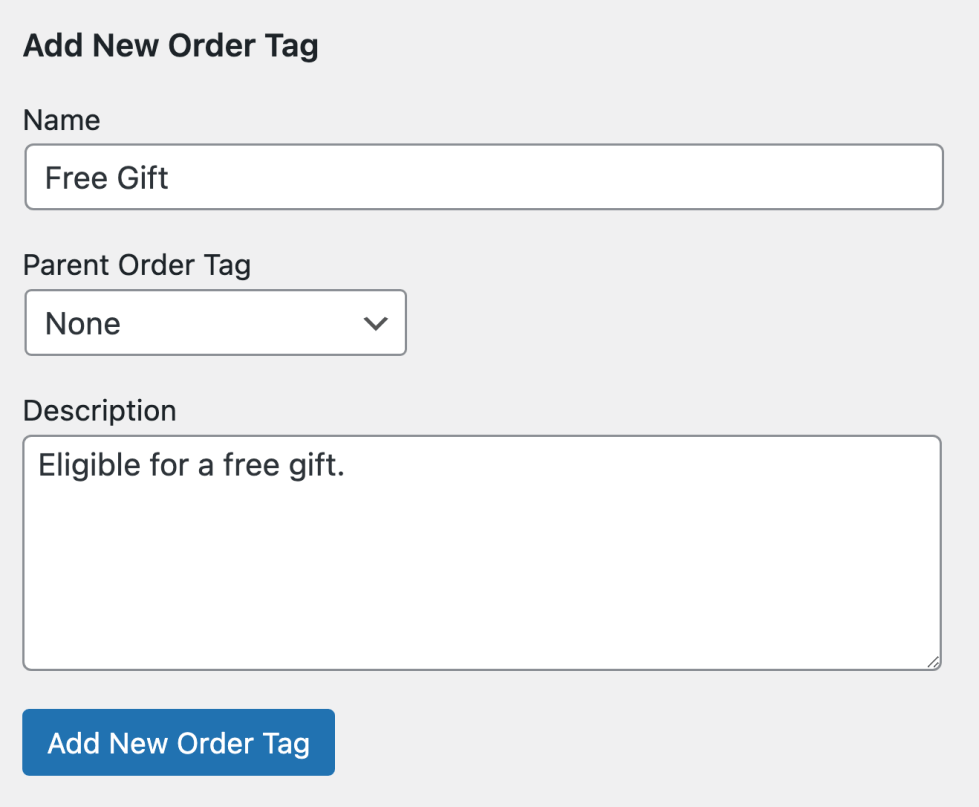
- Name
- Name of the order tag which will be displayed.
- Parent order tag
- Allows you to define the order tag as a child of another order tag, this is purely for managing order tags hierarchically in the dashboard.
- Description
- The description entered will be displayed upon hovering over the order tag on an order.
Edit order tag
↑ Back to topOnce you have created an order tag, it will appear in the dashboard in the table list.
Click on the name of the order tag you wish to edit to reveal the order tag options, such as name, slug, assignment options.

General options
↑ Back to topThere are some general options available, these are populated during the creation of the tag but can be edited if required.
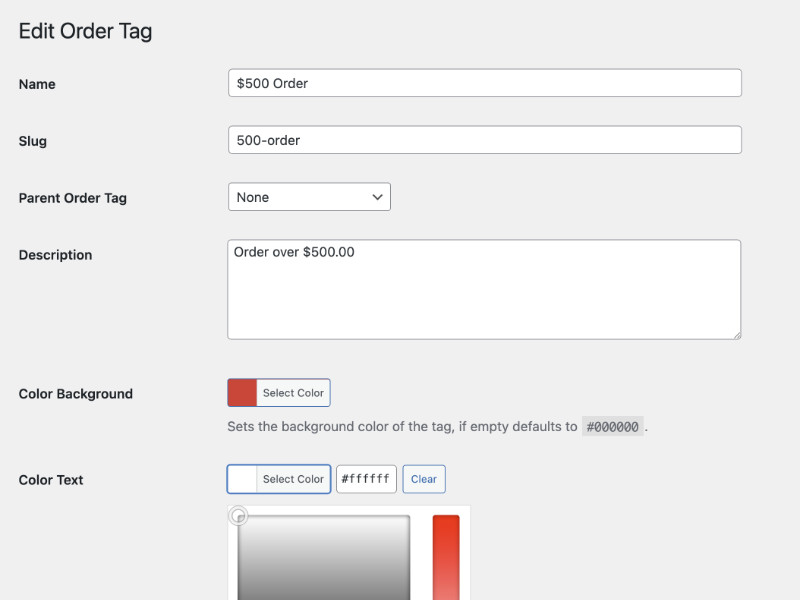
- Name
- Name of the order tag which will be displayed.
- Slug
- A unique reference used for the order tag internally, you can leave this alone, or if you have a specific reason to change the slug you can do so. It is generally recommended to leave this as the default.
- Parent order tag
- Allows you to define the order tag as a child of another order tag, this is purely for managing order tags hierarchically in the dashboard.
- Description
- The description entered will be displayed upon hovering over the order tag on an order.
- Color background
- Sets the background color of the tag, if empty defaults to
#000000.
- Sets the background color of the tag, if empty defaults to
- Color text
- Sets the text color of the tag, if empty defaults to
#ffffff.
- Sets the text color of the tag, if empty defaults to
Assignment options
↑ Back to topOrders can be assigned automatically and/or manually.
Automatic assignment
↑ Back to top“Set on” conditions
When editing an order tag you can apply one or more “set on” automatic assignment conditions.

- On order placed
- Sets the tag when an order is placed via checkout or adding an order via dashboard. Some payment methods may also immediately update the order after it has been placed e.g. to change order status once payment confirmed.
- On order update
- Sets the tag when an order is updated. If a tag is attempted to be removed manually from an order this may cause it to be restored automatically upon update if the “Set If” conditions are met.
- On order subscription renewal
- Sets the tag when a subscription renewal order gets created. Requires WooCommerce Subscriptions, this option is only visible when the WooCommerce Subscriptions extension is active.
“Set if” conditions
Once you’ve set some “set on” conditions, you then need to set some “set if” assignment conditions, if the order matches these conditions the order tag will be automatically assigned upon the “set on” conditions.
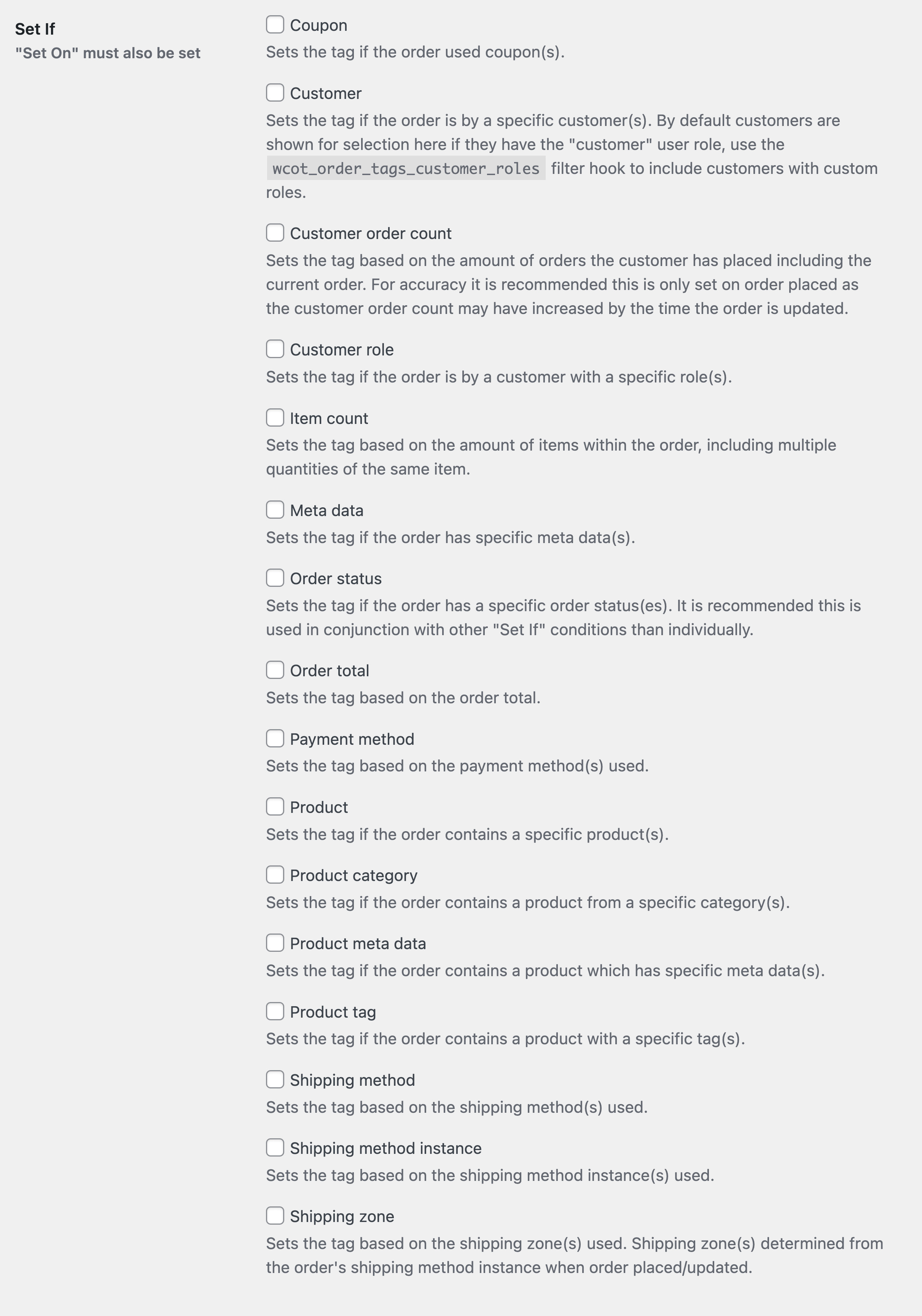
- Coupon
- Sets the tag if the order used coupon(s).
- Customer
- Sets the tag if the order is by a specific customer(s). By default customers are shown for selection here if they have the “customer” user role, use the
wcot_order_tags_customer_rolesfilter hook to include customers with custom roles.
- Sets the tag if the order is by a specific customer(s). By default customers are shown for selection here if they have the “customer” user role, use the
- Customer order count
- Sets the tag based on the amount of orders the customer has placed including the current order. For accuracy it is recommended this is only set on order placed as the customer order count may have increased by the time the order is updated.
- Customer role
- Sets the tag if the order is by a customer with a specific role(s).
- Item count
- Sets the tag based on the amount of items within the order, including multiple quantities of the same item.
- Meta data
- Sets the tag if the order has specific meta data(s).
- Order status
- Sets the tag if the order has a specific order status(es). It is recommended this is used in conjunction with other “Set If” conditions than individually.
- Order total
- Sets the tag based on the order total.
- Payment method
- Sets the tag based on the payment method(s) used.
- Product
- Sets the tag if the order contains a specific product(s).
- Product category
- Sets the tag if the order contains a product from a specific category(s).
- Product meta data
- Sets the tag if the order contains a product which has specific meta data(s).
- Product tag
- Sets the tag if the order contains a product with a specific tag(s).
- Shipping method
- Sets the tag based on the shipping method(s) used.
- Shipping method instance
- Sets the tag based on the shipping method instance(s) used.
- Shipping zone
- Sets the tag based on the shipping zone(s) used. Shipping zone(s) determined from the order’s shipping method instance when order placed/updated.
“Set if” mode
- All
- If set to all then if all of the “Set If” conditions enabled are met it sets the tag.
- Any
- If set to any then if any of the “Set If” conditions enabled are met it sets the tag.
Manual assignment
↑ Back to topTo manually assign order tags to an order there a few options:
- When editing an order you can manually apply any order tag by using the order tags meta box
- On the orders list you can select a number of orders and use bulk actions to assign a specific order tag
If you have an automatic assignment rule on order update those rules may override the manual assignment you are applying e.g. if attempting to remove an order tag.
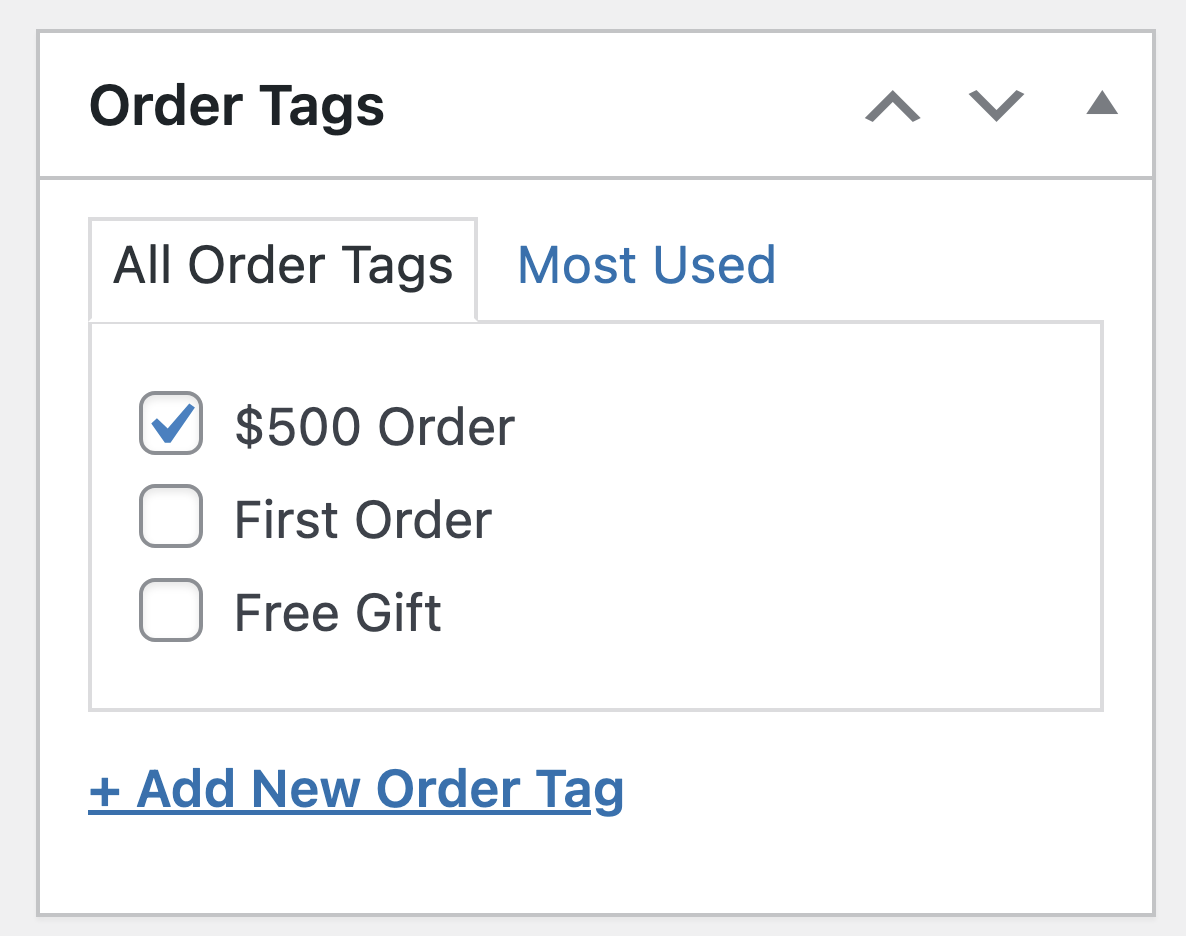
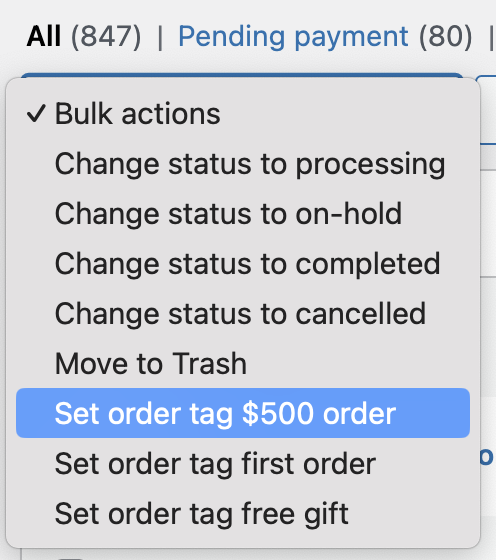
Order management
↑ Back to topOrders list
↑ Back to topFrom the orders list you can see the order tags on each order, filter the list by a specific order tag and perform bulk actions.

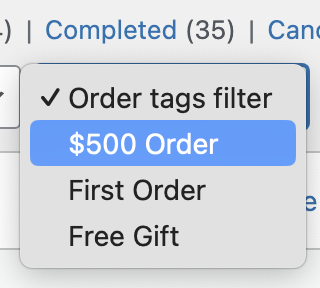

Order details
↑ Back to topWhen viewing an individual order the order tags are shown in the general section.

Bulk set or reset order tags
↑ Back to topThis information is for setting order tags on all your orders, if you simply want to select specific orders and bulk set order tags use bulk actions from the orders list instead.
There are 2 bulk order tag options, these allow you to set order tags on all orders in your store, this is useful if you want to set order tags on orders from before the Order Tags extension was installed or if you want to reset order tags on orders.
To use this functionality you must be logged into your WordPress dashboard and be a user who has the manage_woocommerce capability, which administrators and shop managers have.
- Navigate to the order tags page (by clicking Order Tags from the dashboard menu)
- In the address bar add
&wcot_order_tags_set_tags_bulk=1or&wcot_order_tags_set_tags_bulk=2to the end of the URL e.g.https://yourwebsite.com/wp-admin/edit-tags.php?taxonomy=wcot_order_tag&wcot_order_tags_set_tags_bulk=1&wcot_order_tags_set_tags_bulk=1will set order tags where not previously set&wcot_order_tags_set_tags_bulk=2will remove all order tags from each order (including any manually added order tags) and then will set order tags where not previously set
- Press enter (as if you have typed in a web address and pressing enter to load the page)
- You will then see a notice that the order tags have been set
- We recommend navigation away from the current page (such as by clicking back to the WordPress dashboard), this is just to ensure you don’t refresh the page while still on the
wcot_order_tags_set_tags_bulkbased URL which would trigger another bulk set/reset
If you have a large amount of orders then bulk set or reset order tags is not recommended due to potential time out issues due to the sheer amount of data.
It is not possible for some order tags to be set/reset on old subscription derived orders that were originally created automatically from subscriptions using the bulk set/reset functionality. This is because some of the data required to set the order tags is got from the parent subscription, however in this scenario that subscription may have since been updated with different data than was present at the time the old subscription derived order was placed, so if these order tags were set they might not be correct as the subscription has updated data, so some order tags on old subscription derived orders may not get applied where the data potentially may have been updated on the parent subscription.
It is recommended you take a backup before using this functionality and test on a staging/development environment before performing on a production website.
Export orders with order tags
↑ Back to topOrder tags aren’t saved as order meta, if you wish to export order data including order tags it requires the export process to specifically find the order tag data.
A third party product, Advanced Order Export For WooCommerce by AlgolPlus, allows orders to be exported with order tags, however it requires a specific configuration applying.
Learn how to configure this product specifically for an order tags export in their documentation.
Note that we cannot offer support for this functionality as it is via a third party product.
Custom development
↑ Back to topThe following information is provided for custom development purposes for web developers, they are useful if you wish to add custom features or modify how the extension works. As per the WooCommerce support policy we cannot offer any support for your use of these custom development features.
Filter hooks
↑ Back to top| Filter hook | Description |
|---|---|
wcot_order_tags_color_default | Default hex code background color used for order tags if empty |
wcot_order_tags_color_text_default | Default hex code text color used for order tags if empty |
wcot_order_tags_customer_roles | Customer roles to include customers with custom roles in the set if customer field when adding/editing an order tag |
wcot_order_tags_set_if_product_variations | Allows individual variations of a variable product to be selectable in the set if product order tag assignment field |
wcot_order_tag_taxonomy_args | Filter the register_taxonomy arguments of the order tags taxonomy |
Functions
↑ Back to top| Function | Return |
|---|---|
wcot_order_tags_get_all_order_tags | Array of term objects |
wcot_order_tags_get_order_tags | Array of term objects |
wcot_order_tags_get_order_tag_html | HTML string for specific order tag |
wcot_order_tags_set_order_tag | Array, false or error |
BETA functionality
↑ Back to topWe may occasionally include BETA functionality, this is highlighted with a (BETA) label. Functionality with this label should be used with caution and is only recommended to be tested on a staging/development environment. The functionality is included so users can test the functionality/provide feedback before it becomes stable, at which point the (BETA) label will be removed. Note that there may be occasions where BETA functionality is determined unsuitable for use and removed entirely.
Caching
↑ Back to topIf you are using any form of caching then it is recommended that the cache lifespan/expiry should be set to 10 hours or less. This is recommended by most major caching solutions to avoid potential issues with WordPress nonces.
Screen sizes
↑ Back to top- Frontend: Where elements may be displayed they will fit within the screen width
- Backend: Where interfaces may be displayed it is recommended to use a desktop computer with a resolution of 1920×1080 or higher, for lower resolutions any interfaces will attempt to fit within the screen width but some elements may be close together and/or larger than the screen width
Translation
↑ Back to topWe generally recommend Loco Translate to translate and/or adapt text strings within this product.
Works with
↑ Back to topWhere we have explicitly stated this product works with another product, this should only be assumed accurate if you are using the version of the other product which was the latest at the time the latest version of this product was released. This is because, while usually unlikely, the other product may have changed functionality which effects this product.
FAQs
↑ Back to topIs it compatible with a specific theme?
↑ Back to topThis extension will generally be compatible with most themes. There may be a small number of themes that are fully or partially incompatible due to clashes in functionality and/or if the theme has removed or adapted core WooCommerce functionality. If you would like to know if a specific theme will be compatible before purchase then please contact us and we can advise, it may not be possible for us to determine this e.g. if the theme requires a license and/or several configuration steps. In this scenario you are welcome to purchase and test this extension with the theme and if there is a a compatibility issue you can take advantage of the refund policy for this extension.
Is it compatible with a specific extension/plugin?
↑ Back to topThis extension will generally be compatible with most extensions/plugins. There may be a small number of extensions/plugins that are fully or partially incompatible due to clashes in functionality and/or if the extension/plugin has removed or adapted core WooCommerce functionality. If you would like to know if a specific extension/plugin will be compatible before purchase then please contact us and we can advise, it may not be possible for us to determine this e.g. if the extension/plugin requires a license and/or several configuration steps. In this scenario you are welcome to purchase and test this extension with the other extension/plugin and if there is a a compatibility issue you can take advantage of the refund policy for this extension.
Is it compatible with a specific page builder?
↑ Back to topThis extension will generally be compatible with most page builders. There may be a small number of page builders that are fully or partially incompatible due to clashes in functionality and/or if the page builder has removed or adapted core WooCommerce functionality. If you would like to know if a specific page builder will be compatible before purchase then please contact us and we can advise, it may not be possible for us to determine this e.g. if the page builder requires a license and/or several configuration steps. In this scenario you are welcome to purchase and test this extension with the page builder and if there is a a compatibility issue you can take advantage of the refund policy for this extension.
Support
↑ Back to topIf you need any further assistance with this extension please contact us. Please note that extension support does not include providing assistance with any custom development requirements as per the WooCommerce support policy.